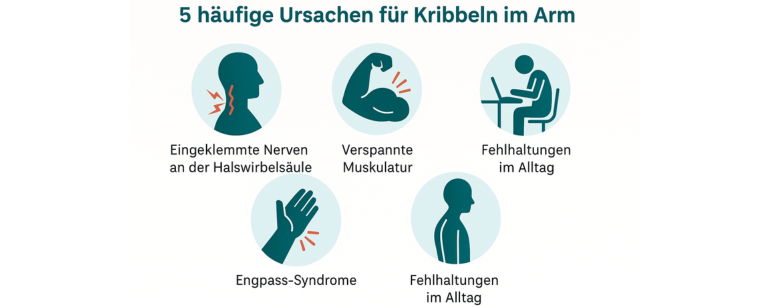A slight tingling sensation in the arm or a numb feeling in the fingers is often ignored. However, recurring complaints are an indication that pressure is being exerted on a nerve somewhere.
In physiotherapy, we often see such symptoms as a result of tension, poor posture or tightness in the cervical spine. They are a warning signal – not an independent problem, but an expression of impaired movement and nerve function.
How tingling and numbness occur
Nerve pathways run from the neck over the shoulder to the hand. If space becomes too tight anywhere along this route, the nerve tissue reacts sensitively. The causes can be mechanical, muscular or postural:
- Irritation of the nerve roots in the cervical spine – e.g. due to disc changes, small blockages or degenerative processes.
- Tense muscles in the neck or chest region that press on the nerve (e.g. the anterior staircase muscle or the small pectoral muscle).
- Poor posture in everyday life, such as working at a laptop for hours on end with your head forward or your shoulders slumped.
- Bottleneck syndromes such as thoracic outlet syndrome or carpal tunnel syndrome, in which nerves are constricted along their course by muscles or connective tissue.
These strains develop gradually. Initially, only a slight tingling sensation is felt, followed later by pain, loss of strength or a dull numbness.

When you should take a closer look
A single episode of the arm falling asleep is harmless. Recurring or persistent symptoms, on the other hand, should be clarified – especially if,
- the sensation occurs unilaterally and regularly,
- Decrease in strength or mobility in the arm,
- neck pain or pressure in the head,
- or the pain radiates to individual fingers.
It is then important to identify the cause early on – the longer a nerve remains irritated, the slower it regenerates.
How physiotherapy can help
Physiotherapy addresses the cause, not the symptom. The aim is to relieve the nerve and restore mobility throughout the shoulder and neck system.
1. manual techniques
Targeted mobilization of the cervical spine and the first ribs to relieve pressure on the nerve roots.
2. soft tissue techniques
Release muscle tension in the neck, chest and shoulder girdle. This normalizes the tension and gives the nerve more space again.
3. posture training and ergonomics
Correction of typical everyday postures, e.g. at the desk or when using a smartphone. Small changes in posture and workplace design make the biggest difference in the long term.
4. active strengthening
Building up stabilizing muscles in the shoulder and trunk area. Strong muscles protect nerves and joints and prevent relapses. Physiotherapeutic treatment addresses the cause, not the symptom. The aim is to relieve the nerve and restore mobility throughout the shoulder and neck system.
What you can do yourself
- Take regular exercise breaks during the working day.
- Regularly mobilize and stretch your neck and chest.
- Upright sitting posture: screen at eye level, shoulders relaxed.
- Check the pillow and mattress – the neck should be stably supported in the lateral position.
Seek professional help early on if the tingling persists. Take regular exercise breaks during the working day.

Conclusion
Numbness or tingling in the arm is usually caused by mechanical stimuli on nerve pathways, rarely by serious neurological disorders. In most cases, the causes can be successfully treated with targeted physiotherapy, posture analysis and active training.
Reacting early can prevent consequential damage and you will soon be able to move again in a relaxed, strong and pain-free manner.
